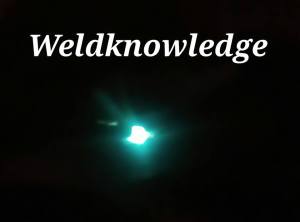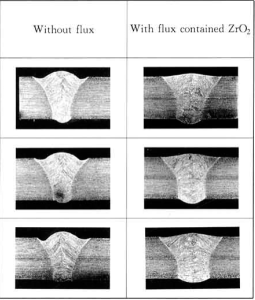The plasma arc welding process is generally operated in keyhole mode. It is found that Undercut, a welding defect, is observed most commonly in keyhole mode PAW process. To avoid such defect activated flux can be used.
Activated flux – We think of only enhancing penetration using activating flux, as it is majorly used with GTAW process to improve quality & productivity. But in PAW process use of activated flux is to provide proper circulation in the weld pool so that undercutting which is commonly observed can be avoided or minimized.
ZrO2, when used as activating flux in plasma arc welding process of stainless steels, it shows reverse effect than in comparison to other fluxes like TiO2, SiO2, and Cr2O3. The melt flow in the weld pool appears to be circulating in the outward direction. This phenomenon will result into rectifying the undercut defect without affecting the penetration.
Below figure shows macrostructure of PAW welds of Type 304 stainless steel.
P.S.: Circulation of liquid in weld pool depends on surface tension gradient which is explained in earlier post ‘Marangoni Effect and Fluid flow in the weld pool’.
Reference: Preliminary study on the mechanism of arc welding with the activating flux.
Keep reading, happy welding
Thank you,
KP Bhatt



All flux used are of oxide type, does they produce any defect in weld?
LikeLiked by 1 person
it depends on the base metal reactivity towards oxygen. Like for titanium base material Fluoride base fluxes are used. MgF2 can be used for Titanium base material.
LikeLiked by 1 person
What is the recommended Activated Flux when Plasma welding SS 316L?
We weld a woven mesh of 0.60mm thickness. The melting at the top surface is very good but the melt at the bottom surface is not uniform. Will activated flux welding solve the problem?
We us below 2 Amps current.
LikeLike